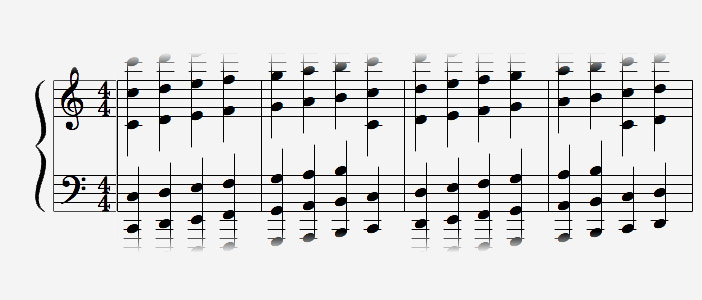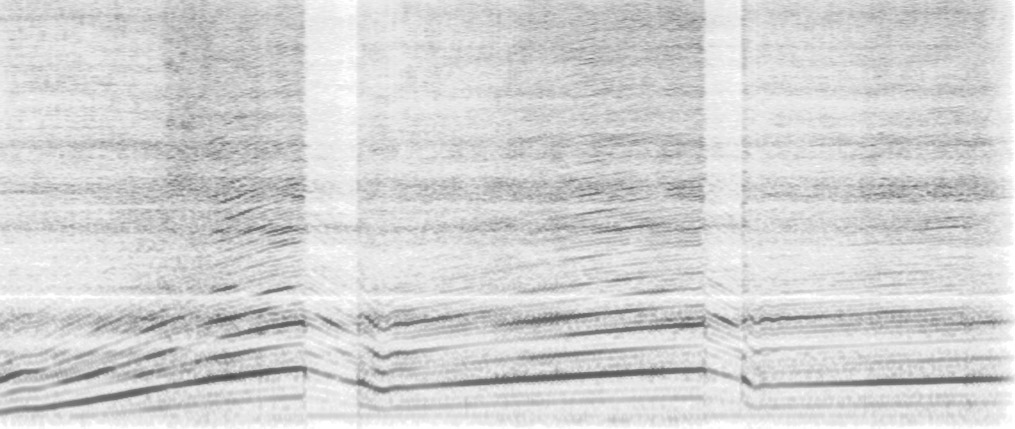The Shepard scale
Invented by Roger Shepard, an American cognitive scientist, the Shepard scale is a musical scale that gives the impression of never-ending rising.
This auditory illusion is achieved by simultaneously playing all same notes separated by one octave (which correspond to the multiples of 2, 4, 8 etc. of the fundamental note). When you go up the scale, the higher notes gradually fade out and the lower notes fade in. The scale thus loops on itself. This principle is similar to the worm screw or the illusion of the Penrose stairs.

This is the chromatic version of Shepard’s scale played on a piano.
Application of the Shepard scale: suspense and tension
An ascending sound usually creates tension. Violinists and guitarists know that: when you change a string on an instrument, you have to tension it to tune it. And this operation is sometimes stressful because with each turn of the peg, the pitch of the string rises and you feel that the string is going to break.
The Shepard range maintains constant tension for a long time thanks to the sensation of continuous rising frequency.
In Dunkirk, by Christopher Nolan, composer Hans Zimmer uses a compositional effect similar to the Shepard scale. He uses a rising scale played by a synthesizer that contains several superimposed notes separated by an octave. Again, the higher notes are gradually replaced by lower notes.

Never ending music
In a more playful register, the Shepard scale allows melodies that never end. The game Super Mario 64 , released in 1996, has a good example. In this game, we find an endless staircase that prevents access to the top before having gathered 70 stars. The music is built with an ascending pattern that loops endlessly, thanks to Shepard’s chromatic scale.
Shepard tone aka Shepard-Risset glissando
Jean-Claude Risset, French researcher and composer, used the Shepard scale principle to create a continuous sound that seems to rise endlessly. The principle is exaclty the same: a stack of gliding sine waves separated by an octave, the higher ones fade out and let the lower ones fade in. With a little practice, we can easily recognize the phenomenon. This effect is often called Shepard Tone.

Application : Sound design
In movies chase scenes, the sound strongly contributes to the sensation of speed. To increase tension, sound editors almost systematically use engine sounds that accelerate . This is much more effective than a continuous engine sound, even if it is running fast. But since an engine cannot accelerate perpetually, editors use gearshifts, which allow the pitch to suddenly fall and then take time to rise. The viewer therefore hears mostly a rising sound , which increases the suspense.
That’s why, if you try counting, some cars in movies drive in 15th gear, while the chase takes place in town!
Below is the sonogram of a car accelerating with two gear changes. We see that the rising sections are much longer than falling sections.

In The Dark Knight , Christopher Nolan overcomes the constraint of shifting gear by using a sound inspired by the Shepard tone (which he seems decidedly to love) for the “batpod” . The engine speed seems to rise continuously throughout the sequence.
By the way, try watching the sequence a second time without sound. You will see that the bat-pod does not drive particularly fast. It’s again the sound that gives this impression!
Other examples
The Shepard tone also works in reverse, and gives the impression of a sound that falls forever. The feeling is no longer a tension but on the contrary a kind of relaxation.
Accompanied by an optical illusion based on fractal images, it creates an incredibly hypnotic sequence.
The infinite acceleration of Risset
This is an other audio illusion which gives the impression that a sound accelerates eternally. It is exactly the same principle as the Shepard tone transposed in the time domain.
Here is how it works : we play an accelerating beat, then we gradually mix it with a second beat, twice slower, which accelerates the same way. Using a multiple allows the two sounds to be mixed seamlessly. Then we gradually add a third beat, four times slower than the first one. When the first beat gets too fast, we fade it out and so on.





